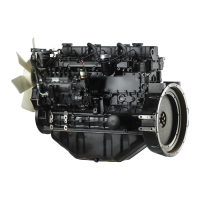
Do you have a question about the Mitsubishi S4S and is the answer not in the manual?
| Brand | Mitsubishi |
|---|---|
| Model | S4S |
| Category | Engine |
| Language | English |
Details the terms and conditions of the warranty provided by Mitsubishi Heavy Industries, Ltd.
Outlines warranty coverage for engine emission control systems per U.S. EPA regulations.
Explains warranty rights and obligations for engines meeting California emission standards.
Specifies warranty periods and conditions for engine components and emission-related parts.
Lists components covered under the emission control system warranty.
Provides crucial safety, operational, and manual usage guidelines for the engine.
Explains the meaning of danger, warning, and caution symbols used in the manual.
Defines measurement units and common abbreviations used in the manual.
Guidelines to prevent fires and explosions from fuel, oil, and electrical hazards.
Instructions for staying clear of rotating and moving engine components during operation.
Precautions for operating the engine in well-ventilated areas to avoid exhaust fumes.
Safety measures for lifting, climbing, and working at heights around the engine.
Recommendations for ear protection and avoiding burns from hot engine parts.
Safe practices for handling fuel, engine oil, and LLC, including disposal.
Actions to take when engine abnormalities like overheating or low oil pressure occur.
Correct procedures for handling and servicing the engine battery.
Important warnings regarding engine modification, work safety, and operational limits.
Illustrations identifying external components of various engine models.
Description and function of key equipment like starter switch and gauges.
Essential inspections before starting the engine, including external, fuel, oil, and coolant levels.
Steps for starting the engine, warm-up operation, and checking oil pressure.
Guidelines for safe and efficient engine operation, including break-in and warning against overload.
Checks to perform during engine operation, such as for leaks, noises, and instrument readings.
Correct methods for stopping the engine, including cooling operation and post-stop inspection.
Details on the type of diesel fuel and its properties required for engine operation.
Instructions for storing, filling, and handling fuel to prevent contamination and fires.
Guidance on selecting the appropriate engine oil and viscosity based on ambient temperature.
Safe handling practices and definitions of key engine oil properties and deterioration mechanisms.
Criteria for determining engine oil replacement based on analyzed properties.
Standards for water quality to be used in the engine cooling system.
Details on genuine and other brand LLCs, their specifications, and handling precautions.
Guidelines for LLC replacement intervals, concentration, and importance in the cooling system.
Examples of problems caused by specific types or degradation of LLC additives.
Explanation of how to interpret and follow the recommended maintenance intervals.
Inspection and adjustment of belts and belt tension.
Procedures for draining water from the fuel tank and filter, and bleeding air from the system.
Steps for replacing fuel filters for in-line and distributor type injection pumps.
Procedures for engine oil and oil filter replacement, draining, and refilling.
Steps for changing, draining, cleaning, and refilling the engine coolant.
Checking the air cleaner, turbocharger, pre-cleaner, and air cleaner element.
Inspection procedures for the battery, starter, and alternator.
Methods for storing the engine in non-operable or operable conditions for extended periods.
Steps for preparing the engine for storage and periodic maintenance during storage.
Instructions for preparing and starting an engine that has been stored.
Guidelines for safely lifting the engine using appropriate equipment and considering its center of gravity.
General advice for troubleshooting, contamination prevention, parts handling, and work safety.
Troubleshooting steps for the starter not cranking or engine failing to start.
Diagnosing and resolving issues like output decrease and abnormal exhaust smoke.
Addressing high fuel/oil consumption and engine overheating or low oil pressure.
Steps to restart the engine after it has run out of fuel, including bleeding the system.
Detailed specifications for S4S, S4S-DT, S6S, and S6S-DT engine models.
